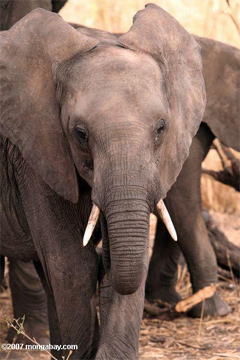Elephants may be key to the mystery of missing bamboo on Mount Kilimanjaro
Elephants may explain Mount Kilimanjaro’s bamboo enigma
Jeremy Hance, mongabay.com
June 25, 2008
|
|
At nearly 6,000 meters in height, Mount Kilimanjaro is both Africa’s tallest mountain and the world’s highest solitary peak, home to a diverse range of habitats that support a large variety of plant species. Yet, unlike any other mountain in Africa, Mount Kilimanjaro contains no bamboo.
Scientists have pondered Mount Kilimanjaro’s missing bamboo for over a century. Some have come to the conclusion that it is a result of dry conditions, but Dr. Andreas Hemp believes he has found another explanation. Speaking at the annual meeting of the Association for Tropical Biology and Conservation (ATBC) in Paramaribo, Suriname, Hemp said that Mount Kilimanjaro had similar rainfall to other tall East African mountains and that the mystery of the missing bamboo is due to a long interplay between elephant and human populations.
 |
Hemp said that large herbivores, like elephants, are essential to bamboo forests on other mountains: “On one hand buffaloes and elephants destroy the forest, creating clearings on openings, which favours bamboo as a light demanding pioneer species. On the other hand these animals bend and pull up old bamboo shoots and dig the soil. This propagates bamboo from fallen culms and fragmentized parts of the rhizomes, enhancing vegetative propagation.”
Elephants are not entirely absent from Mount Kilimanjaro: they live on the northern slope, but it is too dry there for bamboo to develop. However on the southern slope, where the climate is wet enough, there are no elephants. Deep gorges, which the herbivores are unable to traverse, make up parts of this slope, while humans have cultivated the remaining areas. Hemp believes when humans settled the arable land at least 2,000 years ago they also drove the elephants and, by proxy, the bamboo out.
In order to prove that the absense of bamboo on Kilimanjaro is not due to climate, but rather topography, human-influence, and the lack of large herbivores, Hemp plans to conduct pollen analyses to determine if bamboo existed on the southern slope. Discovery of bamboo pollen before human arrival would indicate that Kilimanjaro’s mysterious absence of bamboo is due to human impact on Kilimanjaro’s environment.